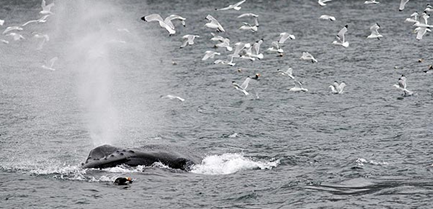
Kenai Fjords National Park
USINFO | 2013-08-21 16:55

The Exit Glacier Ranger Station offers guided walks to glaciers and the ice field, interpretive displays, and other educational programs during the summer season. The terrain in this park is steep and camping/hiking opportunities are fairly limited. Public-use cabins are available in some areas—see map to locate specific cabins.)
Winters are rigorous, with up to 65 feet of snow per year, and although the area is open to snowmobiling, dogsledding, and backcountry skiing, winter visits are recommended only for the well-equipped and experienced.
Wildlife, Bird, and Glacier Viewing
Air charters, available in Seward or Homer, fly over the coast for sightseeing and access to the fjords. Boat tours and boat charters are available from Seward. In summer, boats play the coast observing calving glaciers, seabirds, and marine mammals. Among the many species of birds and wildlife at Kenai Fjords are moose, bear, mountain goats, humpback whales, fin whales, orca, harbor and dall porpoises, harbor seals, Steller sea lions, seabirds, puffins, murres, cormorants, and black-leggedkittwakes.
Fishing Trophy-size fish, fresh into Alaska waters from the open ocean, are a cast away at Kenai Fjords. Boats can be chartered in Seward and elsewhere for overnight fishing trips to the fjords and Resurrection Bay. Saltwater fish found in the waters around Kenai Fjords include halibut, lingcod, and numerous varieties of rockfish. Freshwater fish include Dolly Varden and other trout. Andromanous (migrant) fish include silver, red, chum and pink salmon.
Kayaking
Kayaking opportunities abound in the park, running from McCarty Fjord in the park's southern end to Resurrection Bay at the northeast corner. Independent kayak travel in the fjords is recommended for experienced paddlers only. Novice or experienced paddlers can enjoy a kayaking tour of the park by joining one of the tour operators offering kayaking trips in the area. The area is subject to rough seas and strong tidal currents. Although most experienced paddlers can travel to the fjords from Seward, most kayakers arrange drop-offs and pick-ups with charter boats. Never go within a quarter-mile of tidewater glaciers. Glaciers calve without warning, posing extreme danger from falling ice and cresting waves.
KENAI FJORDS NATIONAL PARK, ALASKA
- From Exit Glacier Nature Center, several short trails lead to the foot of the glacier. The first mile of the main trail is paved and is wheelchair accessible. The pavement ends at a kiosk with benches and interpretive signs about area geology. At that point, you can continue along the main trail on a gravel path to the Glacier, or you can pass through the kiosk and follow the accessible trail to a panoramic viewpoint of Exit Glacier, the surrounding peaks, and the outwash stream.
- Once at the glacier, you can wander along the relatively flat outwash plain, or head up the moderately strenuous Overlook Loop Trail that leads up to an area of recently glaciated terrain, with a spur trail continuing to the edge of Exit Glacier. You can return by the main trail or take the Nature Trail back to the parking lot. This slightly longer, more wooded route includes interpretive signs describing the progression from pioneer plants to temperate rainforest that occurs after a glacier recedes.
- The eight-mile round-trip Harding Icefield Trail is a spectacular day hike. Starting on the valley floor, the trail winds through cottonwood and alder forests, passes though heather filled meadows, and ultimately climbs well above tree line to a breath-taking view of the Icefield. At times gaining 1,000-feet per mile, this trail is strenuous, and you should allow six to eight hours to complete the route.
- This rugged wilderness requires good physical condition, proper equipment, and reasonable precautions. If planning a backcountry trip without a guide, get current, specific information from park staff before starting out. To tackle the Harding Icefield, be prepared to face sudden storms, high winds, blinding sunlight, and extreme temperature changes.
Exit Glacier is the most accessible park area. A gravel road at mile 3.7 of the Seward Highway leads nine miles to the Exit Glacier Ranger Station. The area offers exhibits on the glacier and the Harding Icefield, interpretive programs, and hikes. Rangers provide information daily in the summer. An easy half-mile walk will take you to the glacier's terminus—the first quarter-mile is fully accessible, then a steeper trail continues across moraines and bedrock. You may return to the ranger station by a nature trail. Exit Glacier descends 2500 feet over its nearly three-mile length.
The three-mile Harding Icefield trail, which follows the glacier's flank to an overlook of the icefield, offers a difficult ascent on a steep trail. It's for day use only—overnight backpacking is prohibited. The glacier is active and calving, and falling ice is dangerous. The area beyond the warning signs is strictly off limits. Before attempting this hike, check Park Service bulletin boards for current trail conditions.
Backcountry Travel This rugged wilderness requires good physical condition, proper equipment, and reasonable precautions. If you're planning a backcountry trip without a guide, get current specific information from the park staff before setting out. If you're challenging the Harding Icefield, be prepared to face sudden storms, high winds, blinding sunlight, and extreme temperature changes. Winter travelers to Exit Glacier may face deep snow and cold temperatures. Know the symptoms of hypothermia and their treatment.
Bears are dangerous. Keep a wide distance from black bears and brown/grizzly bears. Make noise when hiking, so you don't startle them. Keep food supplies separate from your campsite and equipment. Food and scented items, such as toothpaste, must be hung or stored in bear-proof containers. Feeding wildlife is unsafe and sets up behavior patterns that may endanger future travelers.
Winter travel to Exit Glacier and the cabin is by cross-country ski, snowmobile, dogsled, or snowshoe. Scenic flights give views of the vast Harding Icefield, and landings can be arranged for day-skiing or expeditions. Obtain Park Regulations for more information on Exit Glacier.
Share this page



















